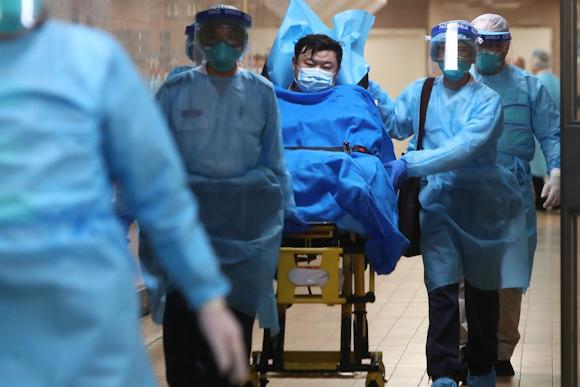In times of a coronavirus epidemic it can be useful, and perhaps even comforting, to know that in China biomedical research has already reached the point of creating biological robots with unusual movement capabilities.
The South China Morning Post reports1, according to which a team of researchers from the University of Shenzhen developed a robot called I-Robot, able to move inside the human body along the blood vessels until it joins the neurons.
It is not the first time that biological structures of this type have been created in the laboratory; never, however, with the characteristics of mobility and the capabilities of the I-Robot, who would be able, during the movement, to cross an obstacle, swim through very small ducts and even vary the dimensions (not exceeding 3 mm) until reaching half of the original one.
- I-Robot they are not powered by chips or batteries, but by a magnetic field generator placed outside, which, as the intensity changes, not only allows to change the size, but also to "induce" a wide range of movements such as oscillations and rolling.
Equipped with a "head" made with an iron-boron neodymium magnet and a "tail" made with special composite material, the body is made of transparent and heat-sensitive hydrogel, which becomes invisible when immersed in water.
 The possibility of use is very wide, even in perspective. The I-Robotin fact, they will also be able to operate within the human body with the task of bringing a drug to a delimited area - a tumor for example - without the danger of creating damage in healthy areas, and thus reducing the risk of side effects.
The possibility of use is very wide, even in perspective. The I-Robotin fact, they will also be able to operate within the human body with the task of bringing a drug to a delimited area - a tumor for example - without the danger of creating damage in healthy areas, and thus reducing the risk of side effects.
Having completed the task, they will leave the body thanks to a machine (such as those of the resonances) which generates the magnetic field necessary for the output procedure.
They will also be able to operate in the brain, an area that is never more inhospitable due to the presence of very rapid blood flows and very small blood vessels.
A procedure, the cerebral one, revolutionary, since currently prostheses can be inserted only by surgical practice, and, due to their limited ability to integrate with neurons, they are able to perform only a few functions.
Finally, the potential that the new technology reserves for the interface with a computer is enormous.
We have already written2 how the USA and CHINA are giving great attention to the brain computer interface (BCI), especially from a military perspective, and the possibility that in a not very remote tomorrow, even I-Robot can also be used in this field, it is not peregrine.
Perhaps also for this reason, the development of organic robots is starting to attract the interest of many universities and research centers.
Recently3 it was also announced by the Salk Institute for Biological Studies in California.

American researchers reproduced in the laboratory new life forms, baptized Xeno-robot, deriving them from stem cells put together with frog cells (hence the prefix Xeno - from ξένος -: foreigner).
Classified as a "programmable living organism", with 1 mm discharge, it is made up of 500-1000 living cells, which can live up to 10 days, able to move in a straight line and in several directions, even in a circle.
To make them in the laboratory, the scientists used a super computer equipped with artificial intelligence, which selected among the thousands of cells existing in nature capable of performing multiple activities, those most suitable for carrying out the actions deemed most useful by researchers.
After selecting the cells, the scientists then joined them by micro-surgical practice with other cardiac and frog skin, finally obtaining the Xeno-robots. Which, despite being described as "programmable living robots", are actually completely organic and made up of biological tissue.
The term "robot" is used only because they can be configured in different forms and "programmed" to operate in a predetermined way. Finally, if damaged, they can also repair themselves.
As in the case of I-Robot, even the Xeno-robots can be used in many fields, not least the military one: just think of the possibility that similar organisms are used to "modify" the vital functions or the functioning of a recipient organ.
The consequence is the urgent need for regulation, which disciplines research in the sector, and identifies an ethical code which the international community must comply with.
In this context, the arrest, in 2018, by the Beijing authorities of He Jiankui, the biophysicist who modified the DNA of two twins when they were still in an embryonic state, using CRISPR technology4 to introduce some genes into an organism, it bodes well for China's determination to supervise its scientific community.
1https://www.scmp.com/news/china/science/article/3046846/meet-chinese-rob...
2https://www.difesaonline.it/mondo-militare/usa-cina-is-your-brain-on-new-field-of-battle
3https://www.pnas.org/content/117/4/1853
4 Clustered Regularly Interspaced Short Palindromic Repeats, expression translatable in Italian with short palindrome repeats grouped and separated at regular intervals [2]) is the name attributed to a family of DNA segments containing short repeated sequences (of phage or plasmid origin) found in bacteria and archei. (Cit. Wikipedia).
Photo: Handout / Chinese Journal of Traumatology / Pnas












